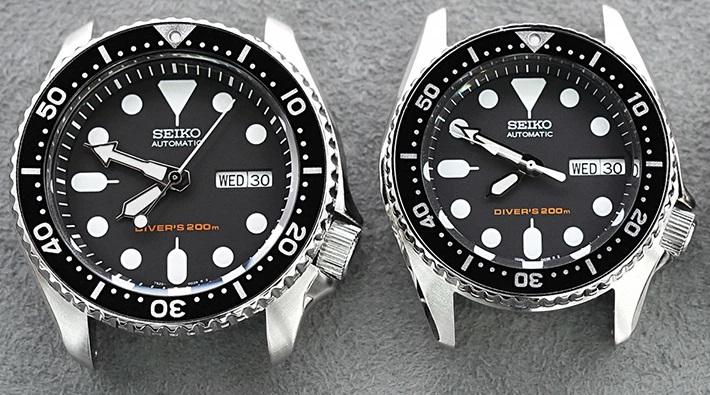Leaderboard
Popular Content
Showing content with the highest reputation on 06/18/20 in Posts
-
Hi This might be useful in explaining the balance shock system and how it operates Watch Anti-Shock Settings - Great British Watch Company.html2 points
-
There was a large (slightly dodgy looking) scrap yard near where I worked, years ago in Coatbridge. Their party piece seemed to be crushing camping gas cylinders in old cars, just for the bang. Coatbridge wasn't the most happening place, so I guess you made your own entertainment.2 points
-
Below is a video of a Peltier cloud chamber. It gives you the ability to see charged particles emanating from a radioactive source. They demonstrate several objects including the source from a smoke detector and a radium lumed watch hand. It even picks up cosmic and environmental radiation. Fascinating, and pretty eerie to watch.2 points
-
Hey, everyone, thanks for the help! After I posted this I couldn't help but ask how she felt and I asked her to wear around my seiko snk for the day, which she loved. She thought i was giving her mine at first because i said it was too small for me, but anyway she's chosen the black one. it looks great on her. Classic choice my friend. I was even thinking about an amphibia. Just wondering, what currency is that website in? I'm seriously going to consider one of these over the SNK. The white one is really cool. I want to also laugh at your joke about me teaching someone how to service a watch movement!! haha I'd have better luck teaching our two year old daughter in ten years :P because that's how long it's going to take me to learn but thanks for the passing vote of confidence :D2 points
-
Hello and welcome. Regarding practice movements, as watchweasol says, Russian and Chinese movements are good and low investment. Both tend to have conventional modern wristwatch movement design, so you learn to recognise the components and where they belong right from the start. Old pocket watch movements are good because of the size. Everything is a lot less fiddly, but many have significant differences to modern movements, which could be an obstacle to a steep learning curve. An exception to this is the Unitas / ETA 6497 or 6498 which has very conventional architecture and is of a size that can even fit in a larger wristwatch case (>42mm). If you decide to do Mark's courses, and judging by the quality of his videos and free tutorials they are well worth it, you will need to get a Unitas / ETA 6497 or 6498 to work on. I think he actually uses a good-quality clone (Seagull ST36) which you can get for a good price on AliExpress. Other Chinese movements are available new or used for very cheap, but the quality varies wildly, and you will struggle to get exact fitting spares if you break something. I have found that generally the higher the quality of the movement, the easier the parts go back together. For example, the Swiss movements from the 50s and 60s were designed and manufactured to be serviceable, and are comparatively easy to work on. Ebay is a good place to shop for these, for a tenner or less. There are cheap mechanical watches from India available, but they apparently bulk-buy scrap movements then canniblalise the worst ones for parts. The result is a running watch, but with dirty, worn, and "non-standard" components. Not good to work on! Having said all that, in your particular circumstances, you might want to look at some alternatives to mechanical watch repair as a means of income. What about simple repairs and battery changes for quartz watches, or cosmetic work (case finishing, modding, individual dials). Just some ideas which might suit your existing skill-set better and give you a quicker way in.2 points
-
There is no harm in taking out and running it without the winder-device, why not find and fix the fault though. I gather it manual winds alright, so keyless is Ok. A fault may exist in the self-winder device itself, a broken pivot or jewel, worn reversers or the rotor bearing. Also broken jewel to the ratchet wheel reduction wheel which is located on the barrel bridge. I would tear down and visually inspect the all autowinder parts. Take pictures in various stages of tear down, comes useful for reassembley also to show us if needed. Good luck2 points
-
Welcome! Love the moniker! I too am working on a "workspace." Nice to have you. Larry1 point
-
1 point
-
Sorry leave it to me to paste the wrong caliber. Just go to Dr ranffts site to see the spring. google like this > raketa 2614 rannft1 point
-
There is another exact looking shock spring on the other side of the balance spring. Here is how it looks.1 point
-
Raketa don't use Incabloc, they use a proprietary version of their own. You may find that a donor movement is your easiest source.1 point
-
When I been working on these Landeron movements, once upon a time it was quite much, for me the most reveling part usually was the type of minute recording jumper. With a type like this my intuition would say it is used mostly on Landeron 48/248 movements or derivates there of. The number (4) hammer for the crhorno function is not a sure tell since it fitts on many of them and because of that parts from various time periods can be found in either of the movements. If one really want to know which movement this is, Landeron always marked them undeneath the balance cock/bridge, just lift it off and the mystery is revealed.(But where is the fun in that) If I choose to close my eyes and not take a look at the dial I personally would be more comfortable finding something like a Venus 175 or Venus 188 under the lid on a watch like this.1 point
-
On a larger scale, if anyone has ever paid a visit to a scrap metal yard and wondered what the large panels on either side of the drive on weight scale were, they're radiation detectors. Radioactive materials can permanently contaminate other metals when they're melted down among a large list of other obvious issues with contamination.1 point
-
This one requires no cooler, but instead uses pressure changes to super saturate the alcohol vapour. A very simple design. The high voltage source is most likely recovered from one of the many dollar store type low cost fly swatter ones, or pretty much anything from the usual suspects on ebay. Try this ebay search -> "12v high voltage generator" The black silicone disk could probably be substituted with a piece of bicycle inner-tube or maybe even a party balloon, and perhaps you could use an aquarium fish tank pump and a release valve to pulse the pressure to give you more controlled or continuous flashes of saturated vapour. Lots of useful ideas.1 point
-
someday when the plague goes away and life somewhat returns to normal maybe you could find somebody locally that has radium hands you can check out your detector. the Geiger counter I have was purchased as a partial kit from a company called maplin the reason for the partial kit I already had the Geiger counter tube. it has a small end window type tube zero idea how well it's calibrated. Has three separate ranges labeled 0.5, 5 an 50 mR/hr. turning it on in the room and the lowest sensitivity every now and then it makes a little chirping sound far enough apart that you wonder if it's broken and then reminded by a little chirping sound. I thought I had banished everything to a faraway location in the house but for some unknown reason there is a bag of brand-new hands of mixed type some of them are blue steel gold color and some have that familiar green colored stuff in the hands. not really desiring to search through the bag for which ones specifically radioactive so as I approach the bag at about 8 inches away the background occasional pop slowly increases at 3 inches you definitely seem to have something that might be radioactive. Holding it up to the bag moving around looking for whatever's most radioactive it looks like I'm getting something in the range of 0.3 to about 0.4. then what else would I have that has radium nearby? Oh my favorite little baby Ben alarm clocks chrome case black dials patent dates of 1920 in 1925. For this I need to change the scale now it's on the five MR scale. Looks like one of the minor problems of small in window tubes it's hard to get it exactly where it needs to be. But I'm easily getting 1.5 and in the right place it will go a little over 2 MR another way if you're not sure if your clocks or radioactive you could try an experiment leave the country go to Canada attempt to come back see what happens. The local chapters around here and the Canadian chapter to the north have a summer picnic and two separate people I don't think was on the same weekend I think it was a couple years apart attempted to return to the US with it ships clock one of those ones with those nice big hands covered with? They both had the weight while they search the car. So the border crossings are much more sensitive to radioactive things I was told that even the fire trucks now all have radiation detectors on them and not sure if I want to know why that is.1 point
-
1 point
-
@Nucejoe the centre-seconds tension spring is not just there to hold the pinion in position. It provides the necessary friction to reduce “slop” in the meshing of the pinion leaves of indirect-drive* seconds. It would be best to put that aspect to one side at the moment as the watch does not run well without it fitted anyway. @patchwerk you will still want to aim for a typical amplitude for the be at isochronism, ie, averaging around 270 degrees over its running time. However, you may find that the balance is so excellently poised on the watch that the positional variation is still acceptable at only 200 degrees. These movements have finer pivots as you say and overall require less torque. This allows the designer to provide less wear and longer running times. The “dog legs” of the escape wheel look ok from what I can see. You can still see the machining marks. Did you use a water-based soap in your ultrasonic cleaner? Occasionally they can leave a greasy film which is hard to detect, especially if the soap solution has been used previously. Presumably you selected the correct GR mainspring - the selection for the similar 500-series movements can be slightly confusing as different thicknesses are quoted.1 point
-
No it isn't. An Alpha particle comprises 2 neutrons and 2 protons, making it a Helium nucleus. The atomic number for Neon is 10, so has 10 neutrons and 10 protons. No, Radium is primarily an alpha emitter, although does also emit beta and gamma. If your detector picks up alpha then it will detect Radium.1 point
-
Didn't you know all us old retired watchmakers glow in the dark.1 point
-
1 point
-
I am, I mean a nuclear Engineer and can assure you, a repairman doesn't intake any worrisome dose of radioactive material, unless you decide to have a radioactive Omlet. Alpha is the nucleus of Neon and absorbs electrons first chance , so it only travels like 5 cm in air. I would keep radioactive luminants out of childerens reach. Most modern luminants are not made of radioactive material. And not practical to protect yourself from background eletromagnetic radiation unless you wear protective clothing made out of materials that shield you from gamma or beta. so, No need to spend money on geiger counter.1 point
-
1 point
-
1 point
-
Hi and welcome to the forum As for tools you already have some cheaper versions so I would upgrade to either A*F brand screwdrivers or the french type, Tweezers of course Dumont . As the drivers and tweezers are the most used get the best you can afford at this time. Watches to practise on Usually advise to but Russian/Chinese, as they dont cost a mint and should you wreck one its no great financial loss, some of the Indian seikos are cheap but are sometimes cobbled movements and useful for practise work. wish you all the best.1 point
-
Hi I have attached a tech sheet fir the ETA. Follow Nucejoes advise and all will be well. ETA 2428.pdf1 point
-
I really hope Sam Cousins wins his case against the Swatch Group. If he doesn't the majority of available watches will only be Chinese in the end.1 point
-
How about one of these? Something pretty "unique" that will last a lifetime if given a service every 10 years. It's an easy movement to service so you could teach her! Anyway, please let us know when you've made your decision!1 point
-
I ask a female friend of the lady to ask her for help to find a ladies watch for her friend. She,the friend, will be speaking the truth because she indeed is a friend of the lady. You can't go wrong because the lady chose the watch herself.1 point
-
is she ok with a mens style watch, larger size, (not huge, less than 45mm)? What colors does she prefer? Does she like diver, Pilot, military, chronographs, vintage, gold, stainless steel? Does she prefer numbers or indices or a mix? is a Date function necessary?1 point
-
Not a lot of information available for the India testers but there is this video I found a few of the things are missing from the video? Then a DIY project if you want to pick up the magnetic field which is one of the things you need to test for. Then just some miscellaneous tests stuff the fourth and fifth link more than you probably want to spend but that's quite reasonable considering what it does. https://youtu.be/V1VpSDa3XyE https://electronicsproject.org/quartz-watch-tester/ http://www.ofrei.com/page256.html http://onatelier.co.uk/new-equipment-workshop-quartz-testing https://webshop.horotec.ch/en/document/article/pdf/USER_MSA19.115_en.pdf https://www.thewatchsite.com/threads/quartz-watch-tester.44041/1 point
-
Hello and welcome to the forum, I have attached a couple of PDFs for your interest. The witschi one may be a bit over your head at the moment but will give you an insight to the complexities of watch repairing. enjoy cheers TZIllustratedGlossary.pdf Witschi Training Course.pdf1 point
-
From the picture it's a classic ceramic variable capacitor. Agreed. The construction suggests it is almost certainly a variable capacitor. One slightly off topic point. A lot of recent low cost multimeters are able to measure frequency (Hz), and I've had good success with these. My main multimeter (the fact that I have several multimeter will probably not come as a great surprise), can measure the .5, 1, 2 or 4Hz on the stepper, and the 32786 Hz of the crystal on most of the quartz watches I've tried it on. If you don't have access to a real quartz watch timing machine a multimeter with a frequency range may well be the next best thing.1 point
-
Yeah bud, The crystal retainer is still on there. You'll need a good four bladed bezel remover or something very strong. It looks like one piece when installed but it does come off. Good luck.1 point












